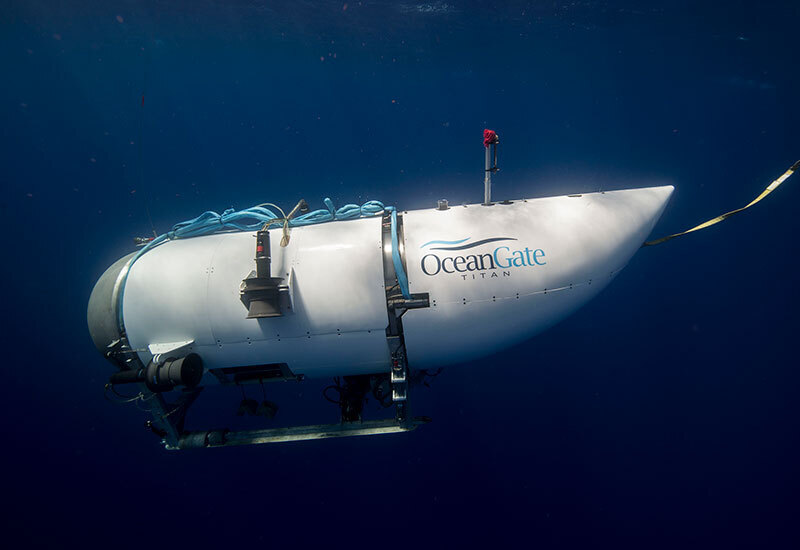Create a free profile to get unlimited access to exclusive videos, sweepstakes, and more!
What Happens When a Submersible Implodes?
It's basically an explosion in reverse.

In March of 2012, James Cameron boarded a one-person submarine and descended to Challenger Deep, the deepest location on the planet. When he was down there, his craft had to endure more than 16,000 pounds of pressure per square inch, more than a thousand times the atmospheric pressure at sea level.
When descending to depths like that, you want to be overwhelmingly sure that your craft can withstand the pressure. Otherwise, you run the risk of a catastrophic implosion like the kind which destroyed the ill-fated Titan submersible on June 18, 2023. After an unsuccessful search and rescue attempt, debris from the submersible was discovered approximately 500 meters from the wreckage of the Titanic, the submersible’s intended destination. The debris was consistent with a catastrophic implosion.
RELATED: Shaken by Titan Disaster, James Cameron Reflects on His Own Undersea Expeditions
We’ve been hearing a lot about implosions lately, but you may not be clear on precisely what they are. They sound suitably close to “explosion” to conjure images of energetically violent destruction, but there’s something about an implosion which strains the imagination. Here’s how they work.
What happens when a submersible implodes?
A rapid change in pressure crushes anything inside with thousands of pounds of pressure per square inch.
The Difference Between an Explosion and an Implosion
We think of explosions as massive balls of fire and shrapnel and they certainly are that, but at its core an explosion is simply a rapid release of energy. What every explosive is trying to achieve is an abrupt change in pressure at the blast site, and they do that pretty well. When an explosive detonates, the fuel inside of it rapidly heats and expands, causing a pressure differential between it and the surrounding environment. The difference in pressure is so severe that the contents of the explosive rapidly expand into the environment. That’s an explosion.
Sure, there is fire and shrapnel but those are secondary symptoms, pressure is the real killer. If an explosion is powerful enough, it can create a shockwave of pressure which travels a significant distance from the blast site. The power of a shockwave is defined by its overpressure: the amount of additional pressure added to the environment, above the typical atmospheric pressure. Basically, it’s a measure of how much force you’re actually feeling, since atmospheric pressure more or less balances out. And it takes a surprisingly small pressure difference to do damage.
RELATED: What (Horrifying) Animals Live Near the Titanic Wreck?
A shockwave carrying one pound of additional pressure per square inch is enough to damage houses. Two pounds of added pressure will cause the partial collapse of walls and roofs. A little more than that and a person’s eardrums will rupture. At three pounds of added pressure, steel frame buildings are pulled from their foundations. Ten pounds of added pressure will cause the complete destruction of buildings and snap wooden utility poles out of the ground. At or above 20 pounds of added pressure per square inch, and you approach 100% fatalities for anyone in the area, according to the CDC.
Implosions are like explosions running in reverse. There’s still an intense pressure differential, but it’s crushing in on you instead of trying to burst out. Inside of a submarine or a submersible, the pressure is a comfortable 14.7 psi, just like on the surface. But the pressure pushing in on you is staggering. Even at the Titanic wreck site, considerably higher than Challenger Deep, the pressure is an overwhelming 6,000 pounds per square inch, roughly 400 times that at sea level.
While the tragic destruction of the Titan is still being investigated, it’s been suggested that minute defects in the submersible’s hull caused an almost instantaneous failure of the vessel. If defects were present, they would have been disproportionately vulnerable to the intense pressure at those depths. Once the hull began to buckle it likely caused an unstoppable collapse. Any vessel with a catastrophic hull breach would experience a rapid change in pressure from one atmosphere to hundreds, in an instant. It would be like having 2,500 elephants stand on you all at the same time. Implosions aren’t as flashy as their more extroverted siblings, but they are just as destructive.
Watch James Cameron venture into the abyss in Deepsea Challenge, streaming now on Peacock!



























